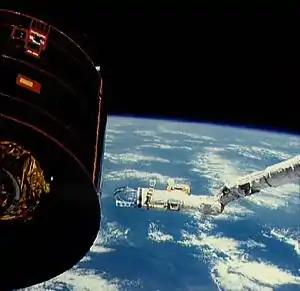 | |
| Names | Space Transportation System-16 |
|---|---|
| Mission type | Communications satellite deployment |
| Operator | NASA |
| COSPAR ID | 1985-028A |
| SATCAT no. | 15641 |
| Mission duration | 6 days, 23 hours, 55 minutes, 23 seconds (achieved) |
| Distance travelled | 4,650,658 km (2,889,785 mi) |
| Orbits completed | 110 |
| Spacecraft properties | |
| Spacecraft | Space Shuttle Discovery |
| Launch mass | 113,802 kg (250,890 lb) |
| Landing mass | 89,818 kg (198,015 lb) |
| Payload mass | 13,039 kg (28,746 lb) |
| Crew | |
| Crew size | 7 |
| Members | |
| EVAs | 1 |
| EVA duration | 3 hours, 6 minutes |
| Start of mission | |
| Launch date | April 12, 1985, 13:59:05 UTC |
| Rocket | Space Shuttle Discovery |
| Launch site | Kennedy Space Center, LC-39A |
| Contractor | Rockwell International |
| End of mission | |
| Landing date | April 19, 1985, 13:54:28 UTC |
| Landing site | Kennedy Space Center, SLF Runway 33 |
| Orbital parameters | |
| Reference system | Geocentric orbit[1] |
| Regime | Low Earth orbit |
| Perigee altitude | 300 km (190 mi) |
| Apogee altitude | 452 km (281 mi) |
| Inclination | 28.45° |
| Period | 94.40 minutes |
| Instruments | |
| |
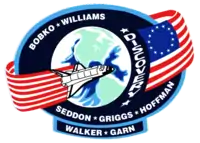 STS 51-D mission patch 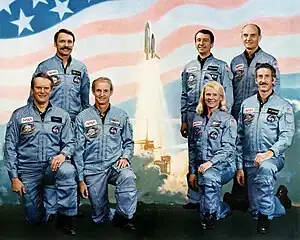 Back row: S. David Griggs, Charles D. Walker, Jake Garn Front row: Karol J. Bobko, Donald E. Williams, Rhea Seddon, Jeffrey A. Hoffman | |
STS-51-D was the 16th flight of NASA's Space Shuttle program, and the fourth flight of Space Shuttle Discovery.[2] The launch of STS-51-D from Kennedy Space Center (KSC), Florida, on April 12, 1985, was delayed by 55 minutes, after a boat strayed into the restricted Solid Rocket Booster (SRB) recovery zone. STS-51-D was the third shuttle mission to be extended.
On April 19, 1985, after a week-long flight, Discovery conducted the fifth shuttle landing at KSC. The shuttle suffered extensive brake damage and a ruptured tire during landing. This forced all subsequent shuttle landings to be done at Edwards Air Force Base, California, until the development and implementation of nose wheel steering made landings at KSC more feasible.
Crew
| Position | Astronaut | |
|---|---|---|
| Commander | Karol J. Bobko Second spaceflight | |
| Pilot | Donald E. Williams First spaceflight | |
| Mission Specialist 1 | Rhea Seddon First spaceflight | |
| Mission Specialist 2 | S. David Griggs Only spaceflight | |
| Mission Specialist 3 | Jeffrey A. Hoffman First spaceflight | |
| Payload Specialist 1 | Charles D. Walker Second spaceflight | |
| Payload Specialist 2 | Jake Garn (U.S. Senator R-UT) Only spaceflight | |
| Garn was a Republican Senator from Utah acting as a congressional observer. He was the first sitting member of Congress in space. | ||
Spacewalk
- Hoffman and Griggs – EVA 1
- EVA 1 Start: April 16, 1985
- EVA 1 End: April 16, 1985
- Duration: 3 hours, 6 minutes
Crew seating arrangements
| Seat[3] | Launch | Landing | 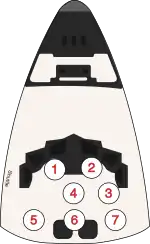 Seats 1–4 are on the Flight Deck. Seats 5–7 are on the Middeck. |
|---|---|---|---|
| S1 | Bobko | Bobko | |
| S2 | Williams | Williams | |
| S3 | Seddon | Hoffman | |
| S4 | Griggs | Griggs | |
| S5 | Hoffman | Seddon | |
| S6 | Walker | Walker | |
| S7 | Garn | Garn |
Mission summary
During STS-51-D, the shuttle crew deployed two communications satellites: Telesat-I (Anik C1) and Syncom IV-3 (also known as Leasat-3); both were Hughes-built satellites. Telesat-I was attached to a Payload Assist Module (PAM-D) motor and successfully deployed. Syncom IV-3, however, failed to initiate antenna deployment and spin-up, or ignite its perigee kick motor upon deployment. The mission was consequently extended by two days to ensure that the satellite's spacecraft sequencer start lever was in its proper position. Griggs and Hoffman performed an unscheduled Extra-Vehicular Activity (EVA) to attach homemade "Flyswatter" devices to the shuttle's Remote Manipulator System (Canadarm). Seddon then engaged the satellite's start lever using the RMS, but again the post-deployment sequence did not begin.[4] The satellite was subsequently retrieved, repaired and successfully redeployed during the STS-51-I mission later that year.
Discovery's other mission payloads included the Continuous Flow Electrophoresis System III (CFES-III), which was flying for sixth time; two Shuttle Student Involvement Program (SSIP) experiments; the American Flight Echo-cardiograph (AFE); two Getaway specials (GASs); a set of Phase Partitioning Experiments (PPE); an astronomical photography verification test; various medical experiments; and "Toys in Space", an informal study of the behavior of simple toys in a microgravity environment, with the results being made available to school students upon the shuttle's return.[5]
During the shuttle's landing at KSC on April 19, 1985, extensive brake damage was suffered, and a landing gear tire ruptured. This prompted future shuttle flights to land at Edwards Air Force Base, California, until effective nose wheel steering could be implemented to reduce risks during landing.
Wake-up calls
NASA began a tradition of playing music to astronauts during the Project Gemini, and first used music to wake up a flight crew during Apollo 15. Each track is specially chosen, often by the astronauts' families, and usually has a special meaning to an individual member of the crew, or is applicable to their daily activities.[6]
| Flight Day | Song | Artist/Composer |
|---|---|---|
| Day 2 | "Top of the World" | The Carpenters |
| Day 3 | "Rescue Aid Society" | Song from the Disney film, The Rescuers |
Gallery
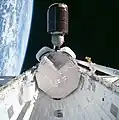 Telesat-I during deployment
Telesat-I during deployment Syncom IV-3 during deployment
Syncom IV-3 during deployment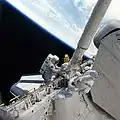 Hoffman and Griggs attach the flyswatter device to the end of the Canadarm.
Hoffman and Griggs attach the flyswatter device to the end of the Canadarm.
See also
References
- ↑ "SATCAT". Jonathan's Space Report. Retrieved March 24, 2014.
- ↑ NASA. "STS-51D Press Kit" (PDF). Retrieved December 16, 2009.
 This article incorporates text from this source, which is in the public domain.
This article incorporates text from this source, which is in the public domain. - ↑ "STS-51D". Spacefacts. Retrieved February 26, 2014.
- ↑ Walker, Charles D. (April 14, 2005). "Oral History Transcript" (PDF) (Interview). Interviewed by Johnson, Sandra. NASA Johnson Space Center Oral History Project. Retrieved December 29, 2011.
 This article incorporates text from this source, which is in the public domain.
This article incorporates text from this source, which is in the public domain. - ↑ "STS-51D". NASA. February 18, 2010. Retrieved January 16, 2018.
 This article incorporates text from this source, which is in the public domain.
This article incorporates text from this source, which is in the public domain. - ↑ Fries, Colin (June 25, 2007). "Chronology of Wakeup Calls" (PDF). NASA. Retrieved August 13, 2007.
 This article incorporates text from this source, which is in the public domain.
This article incorporates text from this source, which is in the public domain.
External links
- NASA mission summary
- STS-51D Video Highlights Archived July 19, 2012, at the Wayback Machine
.jpg.webp)